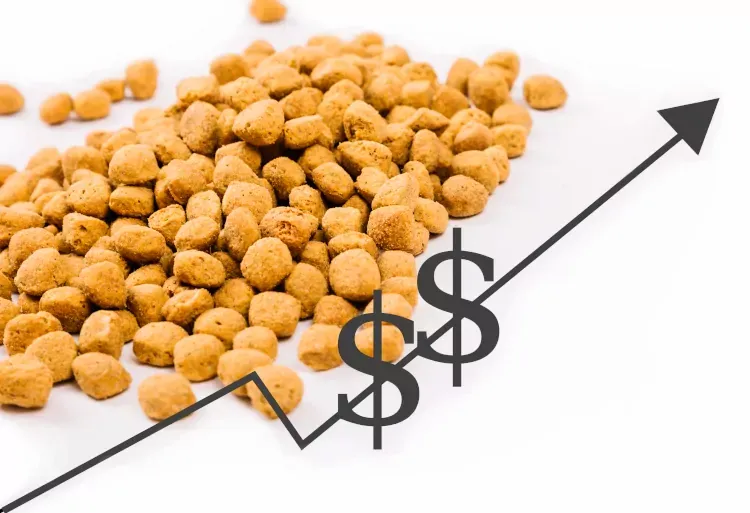Why is Cat Food so High in Carbohydrates?
Despite cats being strict carnivores, most cat foods are very high in carbohydrates. Why so? Carbohydrates are cheap, widely available and filling. They are important for food texture and processing. Carbohydrates ensure a wide profit margin, but in business, the health of cats is a low priority.

Nowadays, the majority of cat carers feed their cats commercial cat food because it is convenient and economical 1. However, these foods can contain anywhere from 35% to 55% carbohydrates.
By comparison, small cats in the wild consume no more than one or two percent carbohydrates 2. So why this huge disparity?
...lowered manufacturing costs
Carbohydrates curb manufacturing costs 1. They are widely available, easy to source and plentiful. Some of them – potatoes, beetroot and sweet potato, for instance – are heavy, bulky ingredients.
This makes them an ideal filler ingredient to compensate for the very sparing use of quality animal protein – if any.
Starchy carbohydrates also fill our cats up. Even though these ingredients are nutritionally worthless to a carnivore, at least they give cats a sense of satiety 2, 3.
...perfect profit promoters
As with all business, pet food is a profit driven industry. Everything else comes after that – including the health of our cats.
Advancement of profit is the sole motivator behind the use of carbohydrates in commercial cat food – not their benefit to cats 4. And carbohydrates are dirt cheap.
By comparison, meat – the one ingredient cats should be filling up on – is expensive. The more expensive the ingredients, the leaner the profit margins.
When the largest volume of a processed food is taken up by a cheap ingredient, less of the expensive stuff is required.
And if you replace quality animal protein with cheap slaughterhouse waste and plant proteins, you have a profit match made in heaven.
...as long as there is some meat present
As much of the quality animal proteins as possible are displaced by inferior animal proteins, carbohydrates and cheap plant proteins. Wheat, corn, peas, beans and soy are firm industry favourites.
As long as there is some meat – regardless of quality – you can say that your product is meat-based.
And this will satisfy most cat carers. Plus, we show our approval by continuing to buy these products.

...affordability is promoted
We have become accustomed to feeding our cats for pennies. And we can do so because we are feeding them cheap food that is made cheaply.
Sadly, we have been programmed to consistently choose convenience and affordability over quality and health.
Besides, the two most important producer-consumer needs are met: Our need for time and money saving solutions and the manufacturer’s need for the best profit margin.
Why would anyone change the status quo?
...the nature of processing
Carbohydrate ingredients, such as grains, root vegetables and legumes, are important for pet food processing 1. Their starchiness is needed to bind ingredients and to produce the required food consistency.
For dry cat food, starches provide structural integrity – the glue that holds the food together and prevents it from crumbling.
Carbohydrates are mixed with denatured protein to ensure an even distribution of ingredients. A carbohydrate–protein interaction also enhances the flavour of food 1.
With moist food, carbohydrates perform a similar role. Even though less carbohydrates are generally needed for moist foods, some level of starch is still required for ingredient distribution and food consistency 1.
Carbohydrates impart gelling properties that create gelatinous, loaf-like consistencies. Starches also thicken gravy-type wet foods.
Different carbohydrate sources produce their own textural characteristics. Each source reacts differently to temperature and processing times, thereby creating a unique texture 1.
...low industry requirements
Even though cats are strict carnivores, only 25% of the cat’s energy needs to be met by a protein source and 20% by a fat source to make cat food acceptable 1.
These standards were set by the American Association of Feed Control Officials (AAFCO) and the European Pet Food Industry (FEDAF). Over time, they have become fairly global industry standards.
Remember that the human food supply is already far from perfect. But pet food is regulated even less stringently, presenting many loop holes. These loop holes are exploited wherever possible and as far as possible to benefit manufacturers.

...our cats are a low priority
Stakeholder profits and growth targets are the industry's top most priorities – not the well-being and longevity of our cats.
To keep manufacturing costs as low as possible, one can be assured that pet food companies will shoot for the lowest specified protein limits, at the lowest passable quality.
In all likelihood, the upper limits for carbohydrate and fat use will also be targeted to reign in costs.
Nowhere in the business equation, does the health of our cats feature. As long as cats can stay alive on a food, that is a good enough.
...what’s next?
If a cash strapped household can make only one change to the cat’s diet is made, what should it be? This article answers the important question.


References
1 Verbrugghe, A. & Hesta, M. (2017). Cats and Carbohydrates: The Carnivore Fantasy? Veterinary Sciences, 4(4), 55; https://doi.org/10.3390/vetsci4040055
2 Morris, J.G. (2002). Idiosyncratic nutrient requirements of cats appear to be diet-induced evolutionary adaptations. Nutrition Research Reviews, 15, 153 – 168.
3 Morris, J.G. (2001). Unique nutrient requirements of cats appear to be diet-induced evolutionary adaptations . Recent Advances in Animal Nutrition in Australia, 13, 187 – 194.
4 Pierson, L.A. (2016). Feeding your cat: Know the basics of feline nutrition. In Cat Info. Retrieved February 7, 2023, from http:// catinfo.org
Disclaimer
The information provided on the Bestfedcats.com website is educational and informational. We are here to give guidance on how to feed a properly balanced raw diet. We also offer advice on how to improve the diet of the modern house cat. Please note that we are not veterinarians. We are not here to give veterinary advice. Best Fed Cats will not be held responsible for any adverse reactions to your cat based on the information on our website. The health of your cat depends entirely on you. We expect you to use your knowledge of your cats, their circumstances and their health – in conjunction with a trusted veterinarian – to determine if any advice provided on this site is appropriate for your cats.

